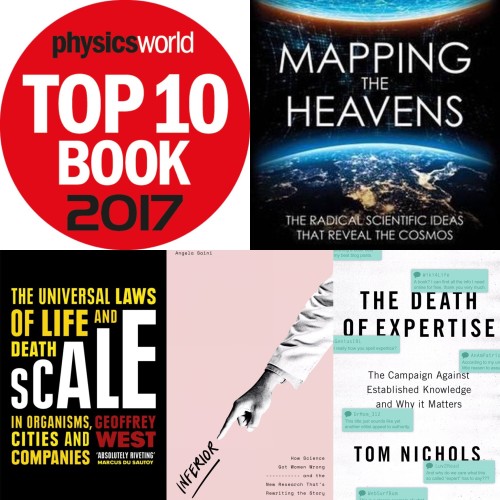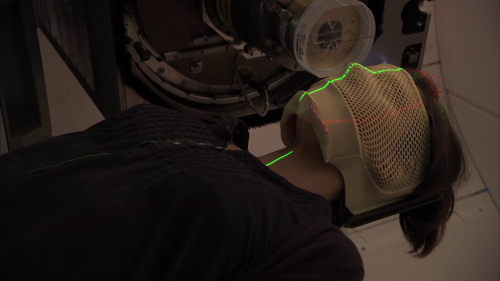Category Archives: General
Physics World’s shortlist for Book of the Year 2017
By Tushna Commissariat
The first week of December can only mean one thing – it’s time to reveal the shortlist for the Physics World book of the year. We’ve based our choice on the 54 books we’ve reviewed over the last 12 months in Physics World, picking our favourite 10 using the same three criteria that have been in place since we launched our book of the year award in 2009. These are that the books must be well written, novel and scientifically interesting to physicists.
Following on from a tumultuous 2016, this year has seen much political strife and human-rights crises, along with the rise of the unexpected demon of “fake news”. Unsurprisingly, the books we reviewed in Physics World this year reflected a lot of these global issues, which means that, along with the usual mix of popular-physics titles, the 2017 shortlist has a few books that at first sight might not seem to have direct links to physics. However, we feel these titles are nevertheless important and relevant to physicists (and of course scientists in general).
Given the number of strong and interesting books on our shortlist, it’s going to be hard to pick a single winner. That, however, is what we shall endeavour to do, via the Physics World podcast next week, when we’ll announce the award-winning book and discuss some of our other favourites on the shortlist. Let us know which ones you have read and are your favourite, and which you may be adding to your Christmas list.
View all posts by this author | View this author's profile
It’s a cracker – the December 2017 issue of Physics World is now out
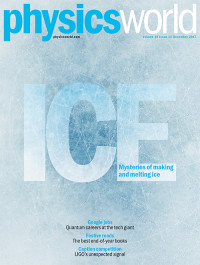 By Matin Durrani
By Matin Durrani
The December 2017 issue of Physics World, which is now out in print and digital format, has some great treats for you.
We’ve got two ice-related features – one by Jennifer Ouellette on a new “inverse” Mpemba effect, which suggests that cold water could warm faster than hot, and the other by two Norwegian researchers studying how best to treat wintry roads with salt.
Then there’s our festive reviews special, where we cast our eye over some of the best end-of-year reads, ranging from the physics of everyday life to extrasolar planets. Plus we review the “tremendous” new documentary about the Voyager missions.
Finally don’t miss our insight into quantum-computing careers at Google plus our great end-of-year LIGO-related caption competition.
Remember that if you’re a member of the Institute of Physics, you can read the whole of Physics World magazine every month via our digital apps for iOS, Android and Web browsers.
View all posts by this author | View this author's profile
LIGO bags another black-hole merger
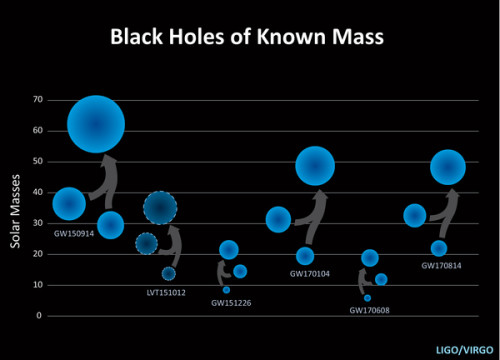
The other ones: five observed black-hole mergers, plus a possible merger shown with dashed outlines (Courtesy: LIGO)
By Hamish Johnston
They have done it again. Physicists working on the LIGO gravitational-wave detectors in the US have announced the observation of another black-hole merger.
This event was spotted on 8 June 2017 and involved two black holes combining to form a black hole 18 times more massive than the Sun. The Virgo detector in Italy did not see the event because it was not switched on. This is the fifth observation of gravitational waves from merging black holes seen by LIGO, which along with Virgo also detected a signal in August from the merger of two neutron stars. Unlike the neutron-star event, no electromagnetic radiation was seen from the merger.
View all posts by this author | View this author's profile
Celebrating the International Day of Medical Physics
By James Dacey
Today is the International Day of Medical Physics (IDMP), as events around the world raise awareness of the vital work carried out by the profession. Now in its fifth year, the 2017 initiative focuses on issues affecting female patients and the safety of women working in medical physics. The theme was chosen to mark the 150th anniversary of the birth of Marie Curie whose pioneering work on radioactivity still underpins various medical treatments and diagnostics – particularly for cancer patients.
“It is well known that medical physicists have developed imaging and radiotherapy methods that have increased women’s length of life and have improved quality of life,” says John Damilakis of the International Organization of Medical Physics (IOMP), which co-ordinates the annual event. “For example, X-ray mammography for the early diagnosis of breast cancer, dual-energy X-ray absorptiometry for the diagnosis of osteoporosis and brachytherapy methods for gynecologic cancer.”
View all posts by this author | View this author's profile
Under the sea: the November 2017 issue of Physics World is now out
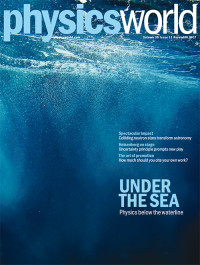 By Matin Durrani
By Matin Durrani
Physicists love a challenge. Some have experiments up in space, while others work deep underground or at the tops of mountains. But just imagine how hard it must be for the those physicists who do experiments at sea.
The November 2017 issue of Physics World, which is now out in print and digital format, examines some of the challenges for physicists working below the waterline.
Jon Willis describes his experience on the exploration ship Nautilus in the Pacific Ocean, looking for mineral-rich “black smokers” that support life in conditions mimicking those on Jupiter’s icy moon Europa. Helen Czerski reveals why her studies of bubbles could help those who model climate change, while Antoine Kouchner and Véronique Van Elewyck explain why and how researchers are using the ocean as a giant neutrino detector.
Remember that if you’re a member of the Institute of Physics, you can read the whole of Physics World magazine every month via our digital apps for iOS, Android and Web browsers.
View all posts by this author | View this author's profile
Happy Dark Matter Day

Darkness to light: the LSST clean room (Courtesy: LSST)
By Hamish Johnston
“On and around October 31, 2017, the world will celebrate the hunt for the unseen…” is the message on the Dark Matter Day website, which has been put together by physicists at universities and research labs across the globe. The site has links to more than 100 online and real-life events taking place in October and November of this year in more than 20 countries worldwide.
Why celebrate dark matter? Why not? After all, the elusive dark stuff appears to account for about 85% of the matter in the universe and its gravitational pull defines the fabric of the cosmos at galactic and greater distance scales. Furthermore, working out exactly what dark matter is could provide valuable information about physics beyond the Standard Model.
View all posts by this author | View this author's profile
The science and policy of green energy

Juliet Davenport at Hampole wind farm near Doncaster. (Courtesy: kalory.co.uk)
By Margaret Harris
In the days following the Great Storm of October 1987, as people across southern England and northern France picked roof tiles and downed tree limbs out of their gardens, Juliet Davenport began thinking seriously about weather.
At the time of the storm, Davenport – now the chief executive of Good Energy, a UK-based supplier and generator of renewable energy – was a third-year physics student at the University of Oxford. She was fascinated to learn that meteorologists (including the BBC’s Michael Fish, who famously told viewers “not to worry” about an approaching hurricane) got their predictions wrong due, in part, to a simple error in the location of ship-based weather observations in the Bay of Biscay, which led them to predict that the storm would follow a more southerly track. “I realized then just how fundamentally sensitive our systems are to data fluctuations,” she told an audience at the University of the West of England (UWE) last night.
Thirty years later, Davenport is still fascinated by the science of weather and climate, but she has also become passionate about the economics of how business becomes an “engine for change” in the world. The role of business in decarbonizing the UK economy was a major theme of her talk. Often, she explained, people regard sustainability and climate change as “someone else’s problem”. That isn’t useful, she said, because “if you expect one part of a society to do all the work, it’s really hard”.
View all posts by this author | View this author's profile
Dialogues on physics, great women who changed science, a virtual reality journey to six exoplanets
By Hamish Johnston
I spend an hour or so every day looking at physics-related websites including several dozen blogs by professional physicists. One of my favourites is Asymptotia by Clifford Johnson, a theoretical physicist at the University of Southern California. Johnson is a talented visual artist and next month he has a new graphic book out called The Dialogues. The above video gives you a taste of what to expect. (more…)
View all posts by this author | View this author's profile
The physics of sperm: the movie
By James Dacey
Luke Skywalker et al. re-entered the public imagination recently with the release of the trailer for Star Wars: the Last Jedi. But where that movie takes you on a galactic adventure, a new short web film by the Wyss Institute in the US takes you on a swashbuckling tour of the microscopic – tracking animated sperm on a mission to fertilize an egg.
The Beginning is based on collaborative work between a pair of researchers at the Wyss Institute for Biologically Inspired Engineering at Harvard University. Founding director Don Ingber teamed up with the biophysicist/professional animator Charles Reilly to seek an atomic-level understanding of sperm movement. Combining molecular dynamics simulations with film animation software, they have visualized how a sperm tail moves based on scientific data.
View all posts by this author | View this author's profile
What gravitational waves did (and didn’t) tell us about GW17081

Rotating into view: Jocelyn Read (centre) and undergraduate students Isabella Molina (left) and Erick Leon. (Courtesy: CQG+)
By Hamish Johnston
The GW170817 neutron-star merger was by no means an instantaneous event. Physicists working on the LIGO-Virgo gravitational-wave detectors were able to watch the two stars spiral towards each other for about 100 s before they merged. Valuable information about the neutron stars has been gleaned from the observation, but the detectors were unable to see the merger itself and its aftermath.
In “The gravitational-wave story of a neutron-star merger”, Jocelyn Read of California State University Fullerton takes up the story at 17 min before the merger. Then, the neutron stars would have been be separated by about 700 km and have an orbital frequency of about 10 Hz.
View all posts by this author | View this author's profile
